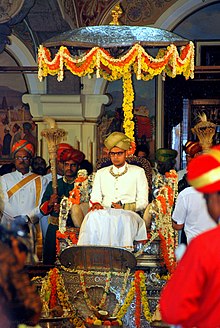This article includes a list of general references, but it lacks sufficient corresponding inline citations. (September 2022) |
| House of Wadiyar | |
|---|---|
 | |
 Yaduveer Krishnadatta Chamaraja Wadiyar, the present head of the family | |
| Country | Kingdom of Mysore |
| Founded | 1399 |
| Founder | Yaduraya Wodeyar |
| Current head | Yaduveer Krishnadatta Chamaraja Wadiyar |
| Final ruler | Jayachamaraja Wodeyar |
| Titles | Maharaja of Mysore |
| Website | www |
The Wadiyar dynasty,(Kannada: [(ʷ)oɖejɐru]) also referred to as the Wadiyars of Mysore (also spelt Wodeyer, Odeyer, and Wadeyar), is a late-medieval Indian royal family of former maharajas of Mysore[1] from the Urs clan originally based in Mysore city.
As Maharajas of Mysore, the Wadiyars ruled the Kingdom of Mysore from the late 1300s until 1950. Members of the Wadiyar dynasty and the Urs clan have also been royal advisers as dewans to their reigning siblings, cousins, nephews, or distant relatives.[1] Some members have also commanded army divisions as dalvoys (commander-in-chief) for their reigning monarch.
During the late 14th century, the family was originally poleygars (Kannada for garrison) defending the regions in and around Mysore town for the Vijayanagara Empire, their feudal overlords. With the fall and decline of the empire in the 17th century, the Wadiyars declared independence when Timmaraja Wodeyar II seized the nearby town of Srirangapattana, the seat of Tirumala, Sriranga II's viceroy, in 1610.[2] Between 1766 and 1799, when Hyder Ali and Tipu dictated the kingdom, the Wadiyar rulers as maharajas were largely nominal without any actual powers.[3] After Tipu's execution in 1799, the East India Company which governed large territories in India at that time restored the kingdom back to the Wadiyars under a subsidiary alliance. After India's independence from the Crown, the ruling Maharaja Jayachamaraja Wadiyar ceded the kingdom to the newly formed Dominion of India.[4]
- ^ a b S, Rajaram N. (12 January 2019). The Vanished Raj A Memoir of Princely India. Prism Books Private Limited. ISBN 978-93-88478-11-3.
- ^ Hüsken, Ute; Narayanan, Vasudha; Zotter, Astrid (1 September 2021). Nine Nights of Power: Durgā, Dolls, and Darbārs. State University of New York Press. ISBN 978-1-4384-8408-2.
- ^ Iyengar, Venkatesa (1932). The Mysore. Mittal Publications.
- ^ Syed, Muzaffar Husain; Akhtar, Syed Saud; Usmani, B. D. (14 September 2011). Concise History of Islam. Vij Books India Pvt Ltd. ISBN 978-93-82573-47-0.
